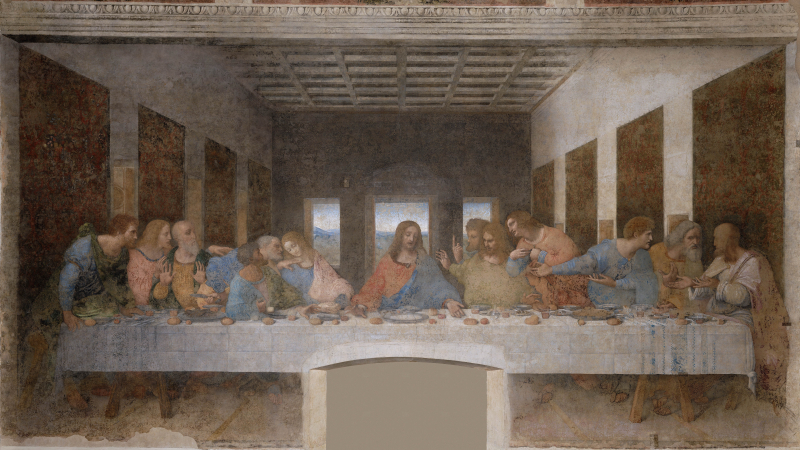The Last Supper
Leonardo da Vinci's "The Last Supper" is a breathtaking mural that captures a critical moment in Christian history. Commissioned by Ludovico Sforza, the Duke of Milan, for the Convent of Santa Maria delle Grazie, this painting measures an impressive 460 x 880 cm. It adorns the end wall of the dining room, a traditional spot for such religious themes. Yet da Vinci's approach was anything but conventional.
The mural depicts the exact moment when Jesus announces that one of his apostles will betray him. This revelation triggers a range of emotions among the apostles, from shock to denial to anger. Da Vinci captures these reactions with unparalleled realism. That creates a dynamic scene filled with tension.
The composition is symbolic and carefully planned. Jesus sits at the center, his right cheek marking the vanishing point of the perspective lines. This technique draws the viewer's eyes towards him. It emphasizes his central role. His hands trace the golden ratio, symbolizing divine perfection. To his right, Judas, the betrayer, is depicted reaching for bread at the same moment as Jesus.
All apostles are arranged on the same side of the table and grouped in threes. They reference the Holy Trinity. Each group reacts differently, showcasing a range of human emotions from disbelief to grief. Da Vinci's ability to portray complex emotions so contributed significantly to the painting's lasting impact.
Art historian Giorgio Vasari praised da Vinci for capturing the apostles' varied psychological responses. Each apostle's facial expressions and body language tell a unique story. From Peter's anger to John's despair and Judas's shock, all are underlined by the shadow that marks him out from the others.
Da Vinci's technique was as innovative as his composition. He painted "The Last Supper" using a secco (dry) technique, deviating from the traditional fresco method. This allowed him more time to refine details and employ his signature sfumato and chiaroscuro techniques. However, this experimental method also meant the painting began deteriorating soon after its completion in 1498. Despite this, the mural remains one of da Vinci's most revered works. Even if what we see today is far from the original.
Key Takeaways:
- Title: The Last Supper
- Artist: Leonardo da Vinci
- Year: Completed in 1498
- Medium: Secco (dry) on plaster
- Size: 460 cm × 880 cm (181 in × 346 in)
- Location: Convent of Santa Maria delle Grazie, Milan













